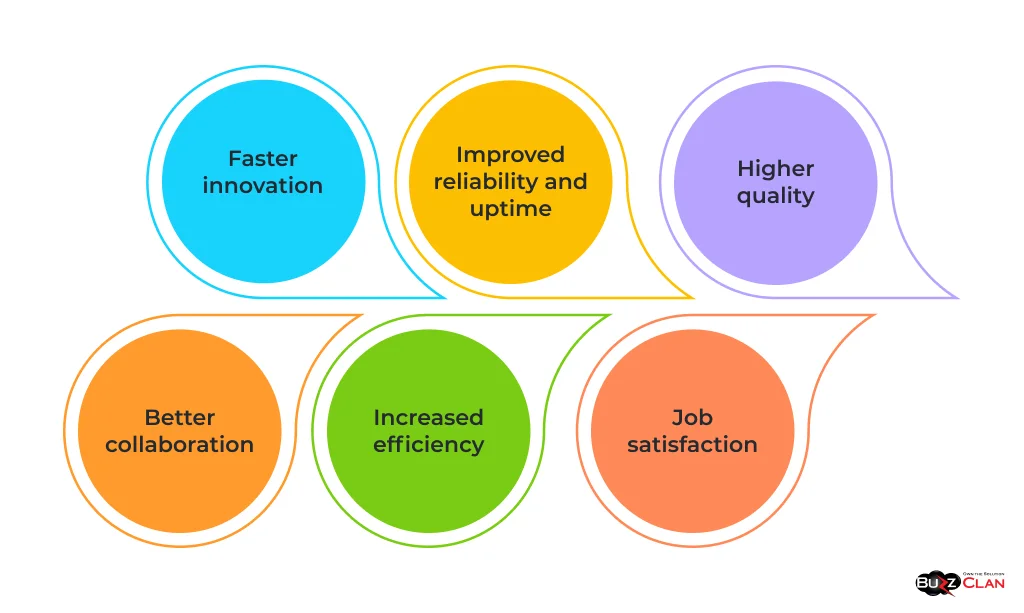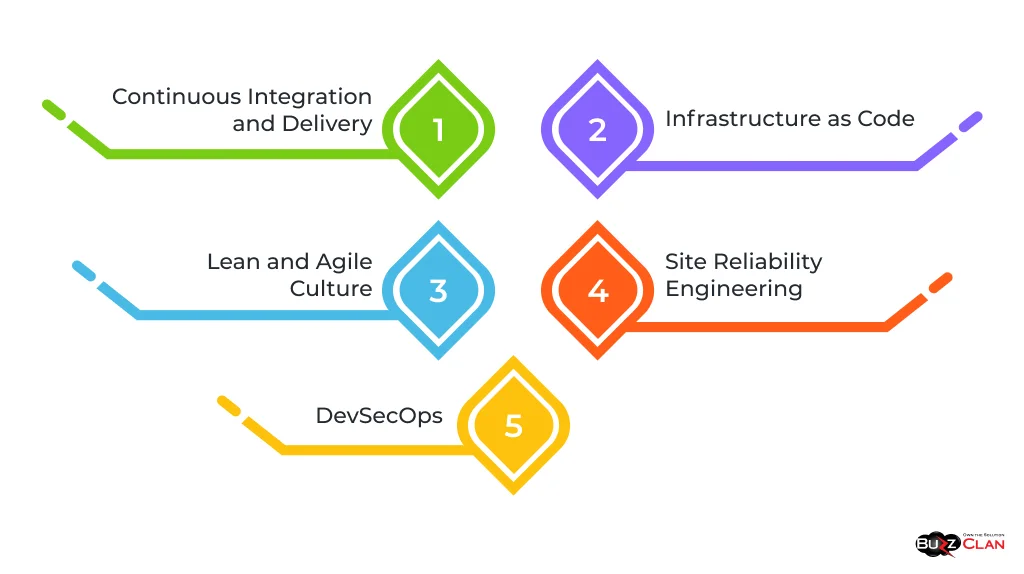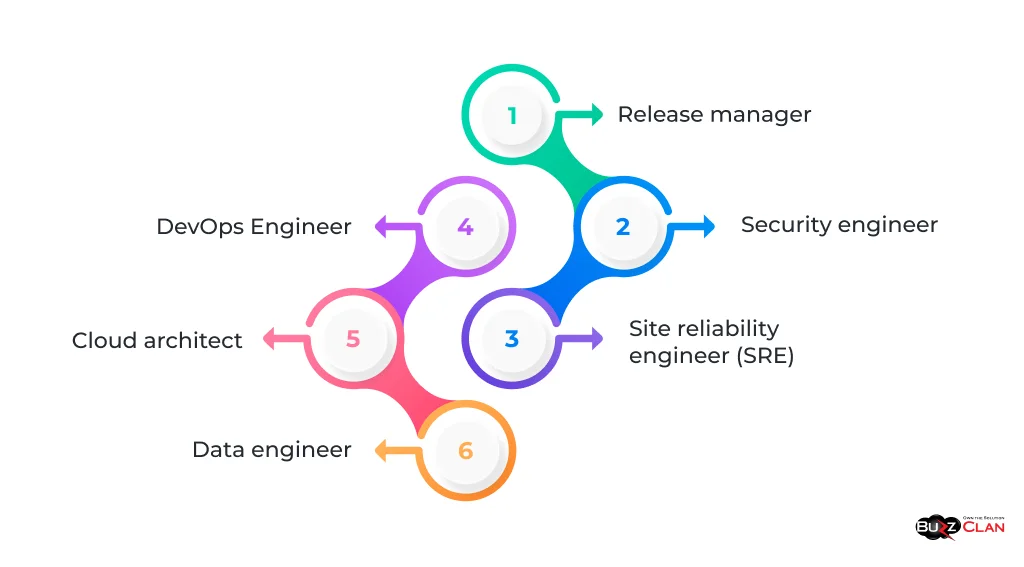What Is DevOps?
Rahul Rao
Feb 22, 2024
Introduction to DevOps
DevOps has transformed how modern software teams operate - bringing development and operations teams closer to delivering higher-quality systems quickly and reliably. This cluster will explore what DevOps entails, its business benefits, cultural pillars, best practices, technologies, and long-term direction.
We'll cover the differentiation between DevOps, Agile, and SRE methodologies. We'll examine the technical and cultural aspects that enable DevOps success. We'll discuss metrics to track and challenges teams may face during adoption.
By the end, you'll have a comprehensive overview of DevOps - how it empowers teams to innovate rapidly while operating resilient systems that provide value to customers. Let's dive in!
What is DevOps?
DevOps integrates software development (Dev) and IT operations (Ops) teams to improve collaboration, productivity, speed, and reliability. It combines technology, practices, and culture to shorten the system development life cycle while enabling frequent, predictable releases.
Core DevOps tenets include:
- Culture of collaboration - Breaking down silos and knowledge sharing across roles - developers, ops engineers, security, QA.
- Focus on automation - Coding and scripting manual processes to enable consistency at scale.
- Continuous processes - Constant flows for building, testing, and releasing instead of batched gates.
- Monitoring and observability - Insights into systems and metrics for optimal uptime.
- Infrastructure as code - Managing networks, servers, and storage in reusable templates.
- Shared ownership - Teams collectively responsible for the entire delivery chain and outcomes.
The tools and techniques used in DevOps help teams standardize workflows, reduce errors caught late, and simplify the complexity when moving code between environments.
This cross-functional integration results in faster software that meets customer needs while minimizing failures, enabling businesses to innovate reliably. DevOps has become the new norm for maturing engineering organizations today.
DevOps vs Agile
Though related, DevOps and Agile are distinct approaches:
Agile is a project management methodology using short iterative cycles for incremental development. It focuses on adaptability and using feedback to align work efforts with business priorities.
DevOps expands Agile principles beyond core development - extending its iterative approach across the entire system lifecycle, including infrastructure, operations, quality assurance, and security.
Both emphasize incremental progress, cross-functional teams, and responding to change. But DevOps drives enhanced collaboration and alignment between all players delivering customer value - not just dev and product teams.
Further Reading
DevOps vs. SRE
Site reliability engineering (SRE) is a discipline that applies IT service management principles to infrastructure and operations work supporting critical systems.
SRE teams focus on availability, latency, performance, capacity, and efficiency to design, monitor, and improve services. SRE documents processes, measures metrics and practices automation, incident response, and root cause analysis.
SRE philosophy complements DevOps cultural norms. SRE ingrains systemic reliability thinking while DevOps speeds and smooths value flow. Together, they deliver robust, evolving systems able to handle modern velocity and complexity.
Why DevOps is Important?

DevOps drives:
- Faster innovation - Reduce cycle times with continuous processes and automation.
- Improved reliability and uptime - Resilient systems through infrastructure as code and monitoring.
- Higher quality - Continuous integration testing reduces bugs escaping to production.
- Better collaboration - Shared ownership between teams towards common goals.
- Increased efficiency - Automate manual tasks to accelerate workflows.
- Job satisfaction - Modern tools and practices keep talent engaged.
Organizations practicing DevOps principles outperform peers in both productivity measurements and market valuations. According to the Accelerate State of DevOps study, top performers deploy code over 100x more frequently than low performers while maintaining 99.995% uptime - demonstrating the power of DevOps culture.
DevOps Business Benefits
Beyond software metrics, DevOps delivers immense value to businesses, including:
- Faster customer feature delivery - Automation and streamlined processes accelerate how quickly engineering teams can build solutions that solve customer and business problems. Being able to respond quickly to market demands gives companies immense competitive advantage.
- Improved quality and resilience - Rigorous testing and monitoring results in fewer system failures. Constant review and iteration harden stability and security -critical for customer trust.
- Higher revenue and market share - Getting ahead of customer pain points expands market opportunities. Better uptimes also directly protect revenue streams tied to web platforms.
- Increased efficiency - Automating tasks eliminates waste and repetition - giving staff more time to create value. Tools integration surfaces data to enhance decision-making.
- Cost avoidance - Outages are enormously expensive - Gartner estimates the hourly cost of downtime at $300K for mission-critical workloads. Minimizing failures saves lost revenue and IT spending.
- Talent recruitment/retention - Engineering satisfaction increases with modern toolsets and upskilling on innovative techniques. Distributed systems result in better resilience and performance.
DevOps Culture and Principles
While great tools help, DevOps is powered by cultural norms that enable teams to operate at higher performance levels. These cultural pillars uphold the effective use of practices and technology:
- Collaboration - Cross-functional transparency, knowledge sharing, and connection across specializations. Aligns priorities between teams.
- Affinity - Shared ownership and collective responsibility across the delivery chain - from code commitment to customer usage.
- Toolchain orientation - Leveraging automation through technology integration to reduce manual toil and bottlenecks.
- Safety culture - Blameless, fail-fast environments foster learning. Progressive risk reduction over perfection.
- Scalability mindset- Architecting for spikes in demand. Capacity planning and right-sizing resources.
- Repeatable practice - Reliable, standardized engineering workflows built on assemblies - infrastructure, build, deploy, monitor.
While culture lives in people, leadership principles, and peer interactions, it is also reinforced through organizational policies, system design, investment priorities, and incentives that create teams for success.
DevOps Culture Challenges
However, evolving culture takes work, given systemic inertia and common hurdles like:
- Resistance to change - Transitioning tools and practices prompts unease and skepticism—open communication and enabling participation help.
- Leadership misalignment - Without executive vision and sponsorship of DevOps, buy-in languishes at lower levels.
- Persistent silos - Unfortunately, "that's not my job" attitudes persist, especially between dev and ops teams. This requires empathy, inclusion, and rotation.
- Measuring culture - Qualities like trust and respect remain elusive. Tactics include engagement and net promoter surveys along with productivity signals.
Culture develops through patience, nurturing relationships, and consistently walking the talk - keeping customer value above internal friction. Maintaining focus on outcomes over outputs lights the way.
DevOps Best Practices and Methodologies

Beyond cultural norms, DevOps also relies on various technical philosophies and frameworks for building and operating software:
Continuous Integration and Delivery
CI/CD pipelines automate build, test, and deployment processes using orchestration tooling like Jenkins, CircleCI, and TravisCI. Code is constantly releasable through incremental changes and adding features using branching strategies like GitFlow.
Benefits include accelerated cycle times, improved quality, and reliability. CI/CD enables teams to release incremental updates more frequently and reliably. Changes can be quickly rolled back if issues emerge post-deployment.
Continuous processes also facilitate infrastructure changes and configuration updates, helping technology stay locked with application evolution.
Infrastructure as Code
Infrastructure configurations - networks, firewalls, servers - are codified through machine-readable definition files using tools like Terraform, Ansible, Chef, and Puppet.
This enables version control for infrastructure, standardization of components, automated deployment, and rollbacks. Benefits include improved consistency, minimized configuration drift, and accelerated provisioning.
Treating infrastructure as code is pivotal for dynamically allocating cloud resources while maintaining reliability. Code constructs remove reliance on specialist knowledge.
DevSecOps
Integrating security earlier into the development lifecycle using compliance testing and vulnerability scanning performed continuously - known as DevSecOps. This increases code quality and reduces risks from software weaknesses or gaps introduced during rapid change.
Automated security unit tests, static code analysis, dynamic analysis, and policy enforcement are embedded into CI/CD pipelines. Security orchestration and automation help scale assurance practices across cloud infrastructures.
Site Reliability Engineering
As discussed previously, regarding organizational culture, site reliability engineering (SRE) incorporates aspects of IT service management to uphold systems assurance - availability, latency, capacity planning, and incidents.
SREs define SLAs, absorb spikes, address outages, and preempt downstream impacts through gamedays, chaos testing, and postmortems. SRE practices perfectly complement DevOps velocity.
Lean and Agile Culture
Foundational Agile manifesto principles guide DevOps cultural norms - valuing collaboration, working solutions, stakeholder partnership, and responding to change. Fostering flow, reducing waste, and working in progress motivate improved system outcomes.
Small iterative steps test assumptions, ensure reversibility, and contain blast radius during failures, enabling innovation. Feedback directs work towards functionality, delivering the most evident customer value.
These philosophies enable DevOps to sustain rapid software improvement while operating performant, reliable enterprise systems - increasingly table stakes for digitally maturing organizations today.
DevOps Toolchain and Technologies
While software delivery and operations practices provide the scaffolding, DevOps is powered by an integrated set of automation tools spanning development, testing, infrastructure management, monitoring, collaboration, and beyond:
Source Code Management Tools
Version control systems like Git and hosted services like GitHub, GitLab, and Bitbucket drive development team collaboration - enabling code review, history tracking, concurrent changes, forks, and workflow management for distributed teams.
CI/CD Tools
Continuous integration and delivery platforms such as Jenkins, CircleCI, TravisCI, TeamCity,AzureDevOps Pipelines, and GitHub Actions automate build, testing, and release processes - transitioning code changes through staging environments toward production rollout.
Infrastructure as Code Tools
Infrastructure configuration management tools like Terraform, Ansible, Chef, and Puppet enable codifying and deploying networking, storage, and servers. Treating stacks as versioned artifacts provides changed awareness and idempotency.
In cloud contexts, infrastructure is dynamically managed as code for improved flexibility - allocating then decommissioning resources based on application requirements.
Monitoring and Logging Tools
Observability tools like Datadog, Splunk, and New Relic ingest metrics, events, and logs to enable system health checks, alarm setting, correlation, anomaly detection, and troubleshooting by leveraging dashboarding, analytics, and alerting capabilities.
Implementing DevOps
Given enhanced rigor across software and system practices, what organizational restructuring helps enable this? What roles fill these gaps? How do we track milestones across the journey?
DevOps Organizational Structures
- Embedded model - Frontline development teams include dedicated DevOps engineers to uplift capabilities. Builds competencies alongside feature work.
- Central platform model - Platform teams provide foundational services - pipelines, tooling, configurations - consumed by application teams. Enables consistency reuse.
- Center of Excellence model - A dedicated group guides best practices and coaches teams rather than executing implementation. It helps steer direction.
- Hybrid model - Combination of embedded subject matter experts collaborating with a centralized enablement team for a multiplier effect. Aligns outcomes.
Team topologies evolve based on current capabilities, pace of change, and abstraction of shared services needed across properties and verticals in the company.
DevOps Roles and Responsibilities

While naming varies across companies, core archetypes working in concert include:
- Release manager - Oversees code flow through environments. Mitigates risk events. Manages schedule conflicts and communications.
- Site reliability engineer (SRE) - Ensures system reliability, uptime, and observability. Sets SLAs and drives remediation. Enables capacity planning.
- Security engineer - Validates controls and practices, recommends improvements, and guards vulnerabilities. Sets policies. Researches latest threats.
- Data engineer - Design pipelines for analytics or transaction pathways. Implements data models upholding quality and minimizes duplication.
- Cloud architect - Designs reference architectures guiding how systems are connected. Consults on trades in solutions—reviews scalability.
- DevOps Engineer - Implements CI/CD build processes. Tests and deploys applications. Automates manual tasks. Supports infrastructure codification.
As bottlenecks shift, responsibilities blend across other project roles, helping spread technical capabilities.
DevOps Challenges and Solutions
However, adapting DevOps broadly has everyday struggles with known remedies:
- Resistance to change - Top-down leadership, proof of concepts showing gains, and including skeptics in planning help overcome inertia and doubt by demonstrating benefits.
- Legacy debt - Strangulation of legacy through path rebuilding, empowering teams to securely experiment accelerates modernization and reduces risk.
- Budget constraints - Taking calculated steps and measuring returns based on automation opportunities builds justification: infrastructure spending reduced through the cloud, toolchain ROI, and productivity lift.
- Talent gaps - Training programs to reskill employees supplemented with external subject matter experts through initial implementations can uplift competencies until internal shared ownership is smoothed.
DevOps Success Metrics

Given the benefits discussed earlier, from system reliability, operational efficiency, and productivity to market responsiveness and revenue protection, how can technology leaders measure DevOps impact through target metrics?
- Lead time- Duration between code commit and go live. Reduced cycle time demonstrates project flow and anticipates value realization.
- Deployment frequency - Release rate per day/week signals engineering throughput and lowers risk burden, allowing teams to deliver innovation faster.
- Change failure rate - The percentage of deployments causing system issues or rollbacks shows progress in optimizing stability - ensuring reliability and trust.
- Mean time to recover (MTTR) - Duration to restore service after an incident indicates operational rigor and uptime.
Lower change failure rates and MTTR combined with increased deployment frequency demonstrate DevOps practices taking hold and driving system maturity - catching errors proactively while responding quickly during anomalous events, ultimately meeting customer expectations.
The Future of DevOps
As modern application and business needs grow more complex, what emerging practices further the DevOps mission?
The rapid growth of cloud-native development using containers, functions, and orchestrators like Kubernetes and serverless to decompose platforms into modular components has catalyzed the usage of microservice architectures, enabling independent scaling. Cloud abstractions simplify maintenance. Statelessness lends resilience.
Expanded security integration into development practice through new testing methods (fuzzing, DAST) and safer encodement tactics like shifting left into building embedded assurance and compliance early in the lifecycle, reducing risk.
Accelerating performance benchmarks like lead time and recovery time as complexity expands requires greater rigors yet quicker issue discovery cycles when exceptions inevitably occur. This demands tighter human-system feedback loops supported by enhanced observation tooling and telemetry.
More widespread adoption of DevOps models has been buoyed as positive outcomes permeate organizations. Top-down sponsorship and grassroots enablement expand usage and investment into integrated practices and platforms.
Advances in test data management, infrastructure definition, and policy automation will provide further guardrails and confidences upholding system integrity as architectures scale in size and distribution across hybrid cloud terrain - on-prem, multi-cloud. Automation ensures consistency.
Conclusion
As modern applications raise user expectations while technologies increase complexity, DevOps has become pivotal in helping teams deliver innovation and improvements quickly, reliably, and securely.
Transitioning to DevOps requires substantial effort and seismic culture shifts, process changes, and technology modernization. However, organizations establishing continuous integration pipelines, adopting infrastructure as code techniques, and infusing cross-functional collaboration unlock immense gains in their ability to evolve systems robustly.
The future direction of DevOps looks bright, given its integral role in nurturing alignment across technology stakeholders, including security, which struggles with similar imperatives - guarding environments without impeding progress as complexity compounds.
By upholding empathetic communication, selecting actionable metrics, and automating thoughtfully, technology leaders can propel their DevOps transformation to help drive competitive advantage for the business through empowered product teams and resilient platforms.
FAQs

Get In Touch
